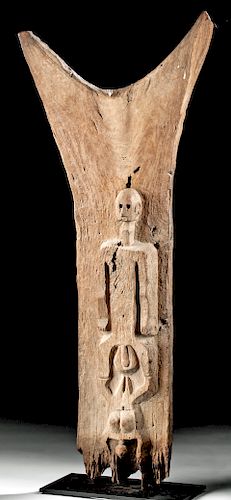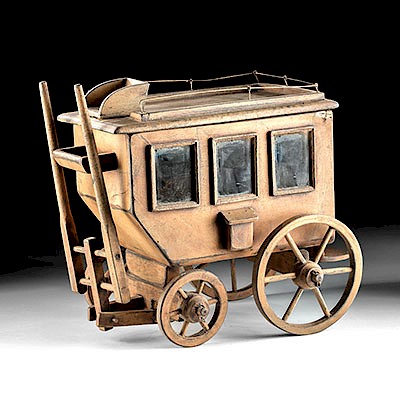Huge / Erotic 20th C. Dogon Wood House Post for Toguna
Lot 116b
About Seller
Artemis Gallery
686 S Taylor Ave, Ste 106
Louisville, CO 80027
United States
Selling antiquities, ancient and ethnographic art online since 1993, Artemis Gallery specializes in Classical Antiquities (Egyptian, Greek, Roman, Near Eastern), Asian, Pre-Columbian, African / Tribal / Oceanographic art. Our extensive inventory includes pottery, stone, metal, wood, glass and textil...Read more
Estimate:
$6,000 - $9,000
Absentee vs Live bid
Two ways to bid:
- Leave a max absentee bid and the platform will bid on your behalf up to your maximum bid during the live auction.
- Bid live during the auction and your bids will be submitted real-time to the auctioneer.
Bid Increments
| Price | Bid Increment |
|---|---|
| $0 | $25 |
| $300 | $50 |
| $1,000 | $100 |
| $2,000 | $250 |
| $5,000 | $500 |
| $10,000 | $1,000 |
| $20,000 | $2,500 |
| $50,000 | $5,000 |
| $100,000 | $10,000 |
| $200,000 | $20,000 |
About Auction
By Artemis Gallery
Nov 14, 2019
Set Reminder
2019-11-14 10:00:00
2019-11-14 10:00:00
America/New_York
Bidsquare
Bidsquare : Ethnographic | Tribal | American Frontier
https://www.bidsquare.com/auctions/artemis-gallery/ethnographic-tribal-american-frontier-4634
Featuring Pre-Columbian, Tribal / Oceanic, Spanish Colonial, historical examples from the Spanish, Mexican, and American frontiers, fossils, and more. All items offered for sale have been legally acquired, are legal to sell and are guaranteed to be as described or your money back. Artemis Gallery info@artemisgallery.com
Featuring Pre-Columbian, Tribal / Oceanic, Spanish Colonial, historical examples from the Spanish, Mexican, and American frontiers, fossils, and more. All items offered for sale have been legally acquired, are legal to sell and are guaranteed to be as described or your money back. Artemis Gallery info@artemisgallery.com
- Lot Description
West Africa, Mali, Dogon people, ca. early 20th century CE. A massive wooden support pole or house post for a togu na (also toguna), a great shelter found in every Dogon village. The pole is Y-shaped at its upper end, branching outward to hold up the roof of the structure. Below that, the post is a wide planar surface with two erotic figures carved in high relief on its face. One of these is a male figure with an elongated neck and a round, bald head with deeply excavated eyes, large ears, and a huge nose. Below the neck, the body is stylized, with a long, rectangular torso and arms of similar rectangular form hanging down at the figure's sides. The legs splay outward, accommodating the oversized genitalia of the obviously male figure. Below him is an upside down female figure, also with oversized genitalia and large breasts that dwarf her head and raised arms. Size: 26.25" W x 62.25" H (66.7 cm x 158.1 cm); 63.5" H (161.3 cm) on included custom stand.
The togu na is the meeting place in the community for male elders. This post would have been about 5.5 feet tall when first made, meaning that the men would have had to crouch and sit inside the low-hanging roof of the shelter - creating a secretive space for sharing confidences and making decisions. The overtly sexual nature of the figures carved on this post symbolize the future of Dogon society - the generations to come from the fertility of the men and women in the community.
See a very similar example at the Art Institute of Chicago (2007.570).
Provenance: private Colorado, USA collection; ex-private Palm Springs, California, USA collection, acquired before 1965
All items legal to buy/sell under U.S. Statute covering cultural patrimony Code 2600, CHAPTER 14, and are guaranteed to be as described or your money back.
A Certificate of Authenticity will accompany all winning bids.
We ship worldwide and handle all shipping in-house for your convenience.
#150971Inactive insect damage and weathering have led to some losses to the peripheries of the piece and some fissures on the surface. The very bottom of the post is lost, but the vast majority of the piece is present. The form is well preserved as is much of the carved artwork. Rich patina on the wooden surface.Condition
- Shipping Info
-
All shipping is handled in-house for your convenience. Your invoice from Artemis Gallery will include shipping calculation instructions. If in doubt, please inquire BEFORE bidding for estimated shipping costs for individual items.
-
- Buyer's Premium



 EUR
EUR CAD
CAD AUD
AUD GBP
GBP MXN
MXN HKD
HKD CNY
CNY MYR
MYR SEK
SEK SGD
SGD CHF
CHF THB
THB














